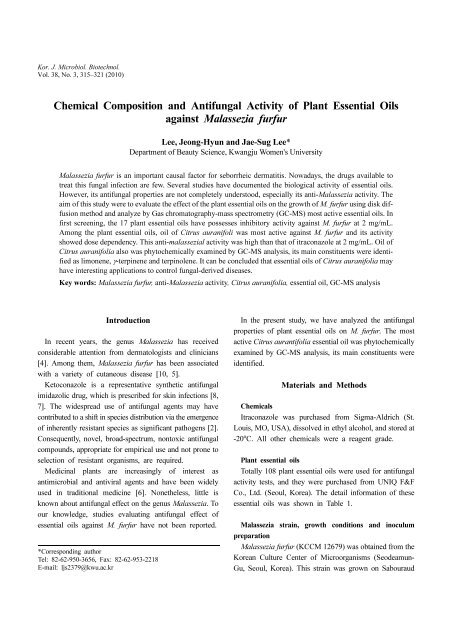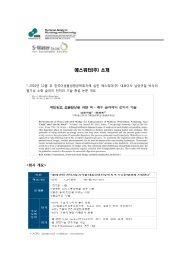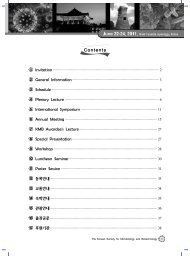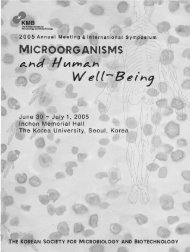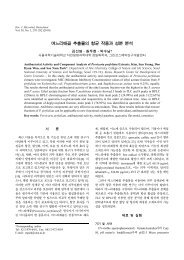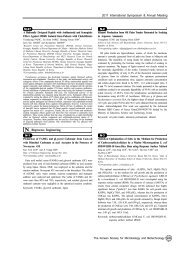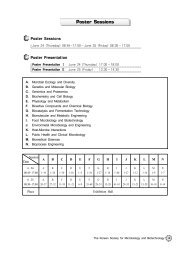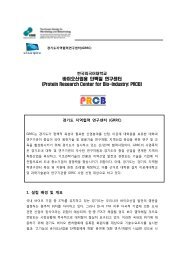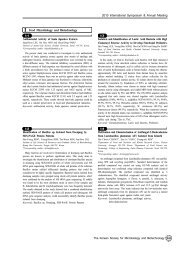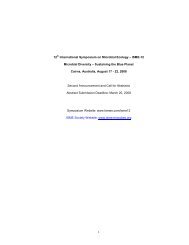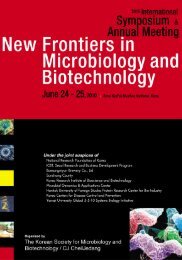Chemical Composition and Antifungal Activity of Plant Essential Oils ...
Chemical Composition and Antifungal Activity of Plant Essential Oils ...
Chemical Composition and Antifungal Activity of Plant Essential Oils ...
You also want an ePaper? Increase the reach of your titles
YUMPU automatically turns print PDFs into web optimized ePapers that Google loves.
Kor. J. Microbiol. Biotechnol.<br />
Vol. 38, No. 3, 315–321 (2010)<br />
<strong>Chemical</strong> <strong>Composition</strong> <strong>and</strong> <strong>Antifungal</strong> <strong>Activity</strong> <strong>of</strong> <strong>Plant</strong> <strong>Essential</strong> <strong>Oils</strong><br />
against Malassezia furfur<br />
Lee, Jeong-Hyun <strong>and</strong> Jae-Sug Lee*<br />
Department <strong>of</strong> Beauty Science, Kwangju Women's University<br />
Malassezia furfur is an important causal factor for seborrheic dermatitis. Nowadays, the drugs available to<br />
treat this fungal infection are few. Several studies have documented the biological activity <strong>of</strong> essential oils.<br />
However, its antifungal properties are not completely understood, especially its anti-Malassezia activity. The<br />
aim <strong>of</strong> this study were to evaluate the effect <strong>of</strong> the plant essential oils on the growth <strong>of</strong> M. furfur using disk diffusion<br />
method <strong>and</strong> analyze by Gas chromatography-mass spectrometry (GC-MS) most active essential oils. In<br />
first screening, the 17 plant essential oils have possesses inhibitory activity against M. furfur at 2 mg/mL.<br />
Among the plant essential oils, oil <strong>of</strong> Citrus auranifoli was most active against M. furfur <strong>and</strong> its activity<br />
showed dose dependency. This anti-malassezial activity was high than that <strong>of</strong> itraconazole at 2 mg/mL. Oil <strong>of</strong><br />
Citrus auranifolia also was phytochemically examined by GC-MS analysis, its main constituents were identified<br />
as limonene, γ-terpinene <strong>and</strong> terpinolene. It can be concluded that essential oils <strong>of</strong> Citrus auranifolia may<br />
have interesting applications to control fungal-derived diseases.<br />
Key words: Malassezia furfur, anti-Malassezia activity, Citrus auranifolia, essential oil, GC-MS analysis<br />
Introduction<br />
In recent years, the genus Malassezia has received<br />
considerable attention from dermatologists <strong>and</strong> clinicians<br />
[4]. Among them, Malassezia furfur has been associated<br />
with a variety <strong>of</strong> cutaneous disease [10, 5].<br />
Ketoconazole is a representative synthetic antifungal<br />
imidazolic drug, which is prescribed for skin infections [8,<br />
7]. The widespread use <strong>of</strong> antifungal agents may have<br />
contributed to a shift in species distribution via the emergence<br />
<strong>of</strong> inherently resistant species as significant pathogens [2].<br />
Consequently, novel, broad-spectrum, nontoxic antifungal<br />
compounds, appropriate for empirical use <strong>and</strong> not prone to<br />
selection <strong>of</strong> resistant organisms, are required.<br />
Medicinal plants are increasingly <strong>of</strong> interest as<br />
antimicrobial <strong>and</strong> antiviral agents <strong>and</strong> have been widely<br />
used in traditional medicine [6]. Nonetheless, little is<br />
known about antifungal effect on the genus Malassezia. To<br />
our knowledge, studies evaluating antifungal effect <strong>of</strong><br />
essential oils against M. furfur have not been reported.<br />
*Corresponding author<br />
Tel: 82-62-950-3656, Fax: 82-62-953-2218<br />
E-mail: ljs2379@kwu.ac.kr<br />
In the present study, we have analyzed the antifungal<br />
properties <strong>of</strong> plant essential oils on M. furfur. The most<br />
active Citrus aurantifolia essential oil was phytochemically<br />
examined by GC-MS analysis, its main constituents were<br />
identified.<br />
Materials <strong>and</strong> Methods<br />
<strong>Chemical</strong>s<br />
Itraconazole was purchased from Sigma-Aldrich (St.<br />
Louis, MO, USA), dissolved in ethyl alcohol, <strong>and</strong> stored at<br />
-20 o C. All other chemicals were a reagent grade.<br />
<strong>Plant</strong> essential oils<br />
Totally 108 plant essential oils were used for antifungal<br />
activity tests, <strong>and</strong> they were purchased from UNIQ F&F<br />
Co., Ltd. (Seoul, Korea). The detail information <strong>of</strong> these<br />
essential oils was shown in Table 1.<br />
Malassezia strain, growth conditions <strong>and</strong> inoculum<br />
preparation<br />
Malassezia furfur (KCCM 12679) was obtained from the<br />
Korean Culture Center <strong>of</strong> Microorganisms (Seodeamun-<br />
Gu, Seoul, Korea). This strain was grown on Sabouraud
316 LEE AND LEE<br />
Table 1. <strong>Antifungal</strong> activities against Malassezia furfur <strong>of</strong> 108 plant essential oils.<br />
Oil Family Species Part <strong>Antifungal</strong> activity (cm)<br />
Garlic Alliaceae Allium sativum L. root 1.0<br />
Cananga Annonaceae Cananga odorata Hook fil. et Thomp. flower - *<br />
Ylang ylang Annonaceae Cananga odorata Hook. f. et Thomson flower - *<br />
Anise Apiaceae Pimpinella anisum L. fruit - *<br />
Aniseed Apiaceae Pimpinella anisum L. fruit - *<br />
Caraway seed Apiaceae Carum carvi L. seed 1.4<br />
Carrot seed Apiaceae Daucus carota L. seed - *<br />
Celery seed Apiaceae Apium graveolens L. seed - *<br />
Cori<strong>and</strong>er Apiaceae Cori<strong>and</strong>rum sativum L. flower - *<br />
Cori<strong>and</strong>er herb Apiaceae Cori<strong>and</strong>rum sativum L. leaf 1.2<br />
Fennel Apiaceae Foeniculum vulgare Mill. seed - *<br />
Galbanum Apiaceae Ferula galbaniflua Boiss.et Buhse root - *<br />
Lovage root Apiaceae Levisticum <strong>of</strong>ficinale L. Koch fruit - *<br />
Parsley herb Apiaceae Petroselinum crispum (Mill.) Nyman whole plant - *<br />
Parsley seed Apiaceae Petroselinum crispum (Mill.) Nyman seed - *<br />
Star anise Apiaceae Illicium verum L. fruit - *<br />
Armoise Asteraceae Artemesia vulgaris L. whole plant - *<br />
Chamomile blue Asteraceae Chamomilla recutita (L.) Rauschert flower - *<br />
Chamomile roman Asteraceae Chamaemelum nobil (L.) All. flower - *<br />
Davana Asteraceae Artemisia pallens Wall. Ex DC whole plant - *<br />
Helichrysum Asteraceae Helichrysum angustifolium DC flower - *<br />
Tagette Asteraceae Tagetes minuta L. leaf - *<br />
Estragon Asteraceae Artemisia dracunculus L. leaf - *<br />
Wormwood Asteraceae Artemisia absinthium L. flower - *<br />
Frankincense Burseraceae Boswellia thurifera Roxburgh root - *<br />
Myrrh Burseraceae Commiphora myrrha var. molmol Engl. stem - *<br />
Tarragon Asteraceae Artemisia dracunculus L. stem - *<br />
Yarrow Asteraceae Achillea millefolium L. flower - *<br />
Cade Cupressaceae Juniperus oxycedrus L. wood - *<br />
Cedarleaf Cupressaceae Thuja occidentalis L. leaf - *<br />
Cedarwood Cupressaceae Juniperus irginiana L. bark - *<br />
Cedarwood Chinese Cupressaceae Juniperus funebris Endl. bark - *<br />
Cedarwood Texas Cupressaceae Juniperus mexicana Spring. bark - *<br />
Cypress Cupressaceae Cupressus sempervirens L. twig - *<br />
Juniperberry Cupressaceae Juniperus communis L. berry - *<br />
Wintergreen Ericaceae Gaultheria procumbens L. leaf - *<br />
Cascarilla bark Euphorbiaceae Croton eleuteria Bennett bark - *<br />
Balsam peru Fabaceae Myroxylon balsamum var. pereirae Royle resin 1.2<br />
Basil Lamiaceae Ocimum basilicum L. flower -<br />
Basil sweet Lamiaceae Ocimum basilicum L. whole plant -<br />
Catnip Lamiaceae Nepeta cataria L. leaf&flower 1.4<br />
Clary sage Lamiaceae Salvia sclarea L. flower - *<br />
Hyssop Lamiaceae Hyssopus <strong>of</strong>ficinalis L. leaf - *<br />
Lavender Lamiaceae Lavaendula <strong>of</strong>ficinalis (Chaiz.) flower - *<br />
Lavender 10/42 Lamiaceae Lav<strong>and</strong>ula angustifolia Mill. flower - *
ANTI-MALASSEZIA FURFUR ACTIVITY OF ESSENTIAL OILS 317<br />
Table 1. Continued.<br />
Oil Family Species Part <strong>Antifungal</strong> activity (cm)<br />
Marjoram Lamiaceae Thymus mastichina L. leaf - *<br />
Melissa Lamiaceae Melissa <strong>of</strong>ficinalis L. leaf - *<br />
Oregano Lamiaceae Origanum vulgare L. leaf 1.4<br />
Patchouly Lamiaceae Pogostemon cablin (Blanco) Benth. leaf -<br />
Peppermint Lamiaceae Mentha piperita L. flower -<br />
Pennyroyal Lamiaceae Mentha pulegium L. leaf 1.0<br />
Rosemary Lamiaceae Rosmarinus <strong>of</strong>ficinalis L. flower - *<br />
Sage Lamiaceae Salvia <strong>of</strong>ficinalis L. whole plant - *<br />
Sage Dalmatian Lamiaceae Salvia <strong>of</strong>ficinalis L. leaf - *<br />
Sage Spanish Lamiaceae Salvia lav<strong>and</strong>ulaefolia Vahl. leaf - *<br />
Savory Lamiaceae Satureja hortensis L. leaf 1.4<br />
Spearmint Lamiaceae Mentha spicata L. flower -<br />
Thyme Lamiaceae Thymus vulgaris L. leaf 1.4<br />
Thyme white Lamiaceae Thymus vulgaris L. leaf 1.3<br />
Cassia especial Lauraceae Cinnamomum cassia Bl. bark - *<br />
Cinnamon bleached Lauraceae Cinnamomum zeylanicum Garc. Ex Blume Nees bark - *<br />
Cinnamon leaf Lauraceae Cinnamomum zeylanicum Blume leaf 1.4<br />
Cinnaom leaf oil terpenes Lauraceae Cinnamomum zeylanicum Garc. Ex Blume Nees leaf - *<br />
Rosewood Lauraceae Aniba roseadora var. amazonica Ducke wood - *<br />
Nutmeg Myristicaceae Myristica fragrans Houtt. seed - *<br />
Eucalyptus Myrtaceae Eucalyptus globulus Labill. leaf - *<br />
Eucalyptus 80/85 Myrtaceae Eucalyptus globulus Labill. leaf - *<br />
Lemon eucalyptus Myrtaceae Eucalyptus citriodora Hook leaf - *<br />
Myrtle Myrtaceae Myrtus communis L. leaf - *<br />
Niaouli Myrtaceae Melaleuca viridiflora Sol. Ex Gaertn. leaf - *<br />
Pimento berry Myrtaceae Pimenta dioica (L.) Merr. flower 1.4<br />
Tea tree Myrtaceae Melaleuca alternifolia (Maid. & Bet.) Cheel leaf -<br />
Clove bud Oleaceae Eugenia caryophyllata Thumb. bud 1.4<br />
Clove leaf Oleaceae Eugenia caryophyllata Thumb. leaf 1.4<br />
Jasmin absolute Oleaceae Jasminum gr<strong>and</strong>iflorum L. flower - *<br />
Pine Pinaceae Pinus sylvestris L. needle - *<br />
Pine needle Pinaceae Pinus sylvestris L. needle - *<br />
Black pepper Piperaceae Piper nigrum L. fruit - *<br />
Citronella java Poaceae Cymbopogon nardus L. leaf 1.3<br />
Geranium Poaceae Pelargonium graveolens L. flower -<br />
Lemongrass Poaceae Cymbopogon citratus (DC) Stapf. whole plant -<br />
Palmarosa Poaceae Cymbopogon martinii Stapf. grass 1.2<br />
Vetiver haiti Poaceae Vetiveria zizanioides L. root - *<br />
Bergamot Rutaceae Citrus bergamia Risso peel - *<br />
Buchu Rutaceae Agathosma crenulata (L.) Pillans leaf - *<br />
Buchu leaf Rutaceae Agathosma betulina (Berg.) Pillans leaf - *<br />
Grapefruit Rutaceae Citrus paradisi Macfadyen fruit - *<br />
Orange Rutaceae Citrus sinensis (L .) Osbeck peel - *<br />
Lemon Rutaceae Citrus limonum L. peel - *<br />
Lemon 10F Rutaceae Citrus limonum L. peel - *<br />
Lime Rutaceae Citrus aurantifolia Swing. peel 2.6<br />
Lime dis 5F Rutaceae Citrus aurantifolia Swing. peel - *
318 LEE AND LEE<br />
Table 1. Continued.<br />
Oil Family Species Part <strong>Antifungal</strong> activity (cm)<br />
M<strong>and</strong>arine Rutaceae Citrus reticulata Blanco peel - *<br />
Neroli Rutaceae Citrus aurantium L. flower - *<br />
Petitgrain Rutaceae Citrus aurantium L. subp. amara leaf - *<br />
Tangerine Rutaceae Citrus reticulata Blanco peel - *<br />
S<strong>and</strong>alwood Santalaceae Santalum album L. wood - *<br />
Valerian Valerianaceae Valeriana <strong>of</strong>ficinalis L. rhizome - *<br />
Rose Rosaceae Rosa damascene Mill. flower - *<br />
Chamomile blue Asteraceae Chamomilla recutita (L.) Rauschert flower - *<br />
Estragon Asteraceae Artemisia dracunculus L. leaf - *<br />
Lemongrass Poaceae Cymbopogon citratus (DC) Stapf. whole plant - *<br />
Bay Myrtaceae Pimenta racemosa (Mill.) J.W.Moore leaf 1.3<br />
Litsea cubeba Lauraceae Litsea cubeba L. fruit - *<br />
Tamanu Clusiaceae Calophyllum inophyllum L. fruit - *<br />
Xanthoxylum Rutaceae Zanthoxylum armatum seed - *<br />
Eucalyptus Myrtaceae Eucalyptus citriodora leaf - *<br />
Ginger Zingiberaceae Zingiber <strong>of</strong>ficinale Roscoe rhizome - *<br />
Itraconazole 1.5<br />
Samples treated with concentration <strong>of</strong> 2 mg. ‘- * ’ expressed no activity.<br />
Dextrose Broth (SDB) or Sabouraud Dextrose Agar (SDA)<br />
(Difco, Sparks, MD, USA) supplemented with 1% (v/v) <strong>of</strong><br />
pure olive oil (Yakuri Pure <strong>Chemical</strong>s, Kyoto, Japan),<br />
following incubation at 37 o C during 2-7 days. Malassezia<br />
strains were maintained on the same medium described<br />
previously, at 4 o C, with subcultures being carried out on a<br />
monthly basis. The same medium was used in all the<br />
experiments. Inoculum suspensions were prepared by the<br />
method as described previously [14]. One milliliter <strong>of</strong> 48 h<br />
culture was centrifuged (3000 g at 4 o C for 1 min), followed<br />
by washing the pellets twice with 1 mL <strong>of</strong> phosphate<br />
buffered saline (PBS). Clusters <strong>of</strong> Malassezia cells were<br />
formed upon preparation <strong>of</strong> inoculum suspensions. The<br />
washing <strong>of</strong> these suspensions with PBS promotes singlecell<br />
status <strong>and</strong> more accurate turbidity measurements.<br />
<strong>Antifungal</strong> activity<br />
The antifungal activity <strong>of</strong> the plant essential oils was<br />
carried out by minor modification <strong>of</strong> previous method using<br />
100 µL <strong>of</strong> suspension containing 5×10 6 CFU/mL <strong>of</strong> M.<br />
furfur [1]. The discs (6 mm in diameter) were impregnated<br />
with 10 µL <strong>of</strong> essential oil diluted with 95% ethanol under<br />
aseptic conditions <strong>and</strong> placed on the inoculated agar.<br />
Negative controls were prepared using the same solvent<br />
that was spread on the agar plates. In first screening, the<br />
disks (Whatman, 6 mm in diameter) impregnated with<br />
essential oil <strong>of</strong> 2 mg/mL <strong>and</strong> were placed on the inoculated<br />
agar. The selected oil impregnated with 1.5 mg/mL, 1.0<br />
mg/mL, 0.5 mg/mL, <strong>and</strong> 0.1 mg/mL also was placed on the<br />
inoculated agar. Itraconazole <strong>of</strong> four concentrations were<br />
used as positive reference st<strong>and</strong>ards. The antifungal activity<br />
was evaluated by measuring the inhibition-zone diameter<br />
observed after 48 h <strong>of</strong> incubation.<br />
Gas chromatography (GC-FID)<br />
Gas chromatography analysis was performed on the<br />
Agilent 6890N equipped with a DB-1MS column (30 m×<br />
0.25 mm i.d., 0.25 um film thickness, J&W Scientific,<br />
Folsom, CA). The oven temperature was programmed as:<br />
isothermal at 40 o C for 1 min, then raised to 250 o C at 6 o C/<br />
min <strong>and</strong> held at this temperature for 4 min. Helium was<br />
used as the carrier gas at the rate <strong>of</strong> 1.5 mL/min in split<br />
mode (50 : 1 ratio). The constituents <strong>of</strong> the plant essential<br />
oil were identified by comparing their GC retention indices<br />
(RI). RI <strong>of</strong> each constitutes <strong>of</strong> plant essential oil were<br />
obtained by co-injection <strong>of</strong> essential oil <strong>and</strong> a mixture <strong>of</strong><br />
aliphatic hydrocarbons (C8-C20; Sigma-Aldrich, St. Louis,<br />
USA). RI was calculated using the equation proposed by
ANTI-MALASSEZIA FURFUR ACTIVITY OF ESSENTIAL OILS 319<br />
van Den Dool <strong>and</strong> Kratz (1963) [15].<br />
Gas chromatography-mass spectrometry (GC-MS)<br />
The essential oils <strong>of</strong> Citrus aurantifoliaa was analyzed<br />
on a gas chromatograph (Agilent 6890N)-mass spectrometer<br />
(Agilent 5973N MSD) equipped with a DB-5MS<br />
column (30 m×0.25 mm i.d., 0.25 um film thickness, J&W<br />
Scientific, Folsom, CA). The oven temperature was programmed<br />
as for the previous analysis. Helium was used as<br />
the carrier gas at the rate <strong>of</strong> 1.0 mL/min. Effluent <strong>of</strong> the GC<br />
column was introduced directly into the source <strong>of</strong> the MS<br />
via a transfer line (250 o C). Ionization voltage was 70 eV<br />
<strong>and</strong> ion source temperature was 230 o C. Scan range was 41-<br />
450 amu. Compounds were tentatively identified by comparison<br />
<strong>of</strong> mass spectra <strong>of</strong> each peak with those <strong>of</strong><br />
authentic samples in the NIST MS library.<br />
Results <strong>and</strong> Discussion<br />
<strong>Antifungal</strong> activity <strong>of</strong> 108 plant essential oils was found<br />
when the essential oil was assayed at 2 mg/mL (Table 1).<br />
The results showed the inhibitory effects <strong>of</strong> 17 oils [Allium<br />
sativum L., Carum carvi L., Cori<strong>and</strong>rum sativum L.,<br />
Myroxylon balsamum var. pereirae Royle, Nepeta cataria<br />
L., Origanum vulgare L., Mentha pulegium L., Satureja<br />
hortensis L., Thymus vulgaris L. Thymus vulgaris L.,<br />
Cinnamomum zeylanicum Blume, Pimenta dioica (L.)<br />
Merr., Eugenia caryophyllata Thumb.(Clove bud), Eugenia<br />
caryophyllata Thumb. (Clove leaf), Cymbopogon nardus<br />
L., Cymbopogon martinii Stapf., Citrus aurantifolia Swing.<br />
<strong>and</strong> Pimenta racemosa (Mill.) J.W.Moore] on M. furfur at<br />
2 mg/mL. These oils showed similar inhibitory activity to<br />
itraconazole at 2 mg/mL. Among the 17 active oils, only<br />
the Citrus auranifolia essential oil exhibited strong inhibitory<br />
activity at dose dependent manner <strong>and</strong> the activity<br />
was higher than itraconazole at same concentration (Fig. 1).<br />
The chemical compositions <strong>of</strong> the antifungal essential oil<br />
are shown in Table 2. A total <strong>of</strong> 15 compounds were identified<br />
in Citrus auranifolia oil by GC <strong>and</strong> GC-MS analysis.<br />
Among the identified compounds, limonene (51.07%) was<br />
the most abundant compound <strong>and</strong> γ-terpinene (14.29%) <strong>and</strong><br />
terpinolene (11.32%) were followed (Table 2).<br />
Malassezia species are associated with a number <strong>of</strong><br />
dermatological disorders including d<strong>and</strong>ruff/seborrheic dermatitis<br />
<strong>and</strong> pityriasis versicolor [3]. In general, for treatment<br />
<strong>of</strong> such illnesses, azole drugs such as fluconazole <strong>and</strong><br />
Table 2. <strong>Chemical</strong> composition <strong>of</strong> Citrus aurantifolia essential<br />
oil.<br />
Compound RI * Relative composition ratio, %<br />
α-pinene 928 0.58<br />
β-pinene 967 1.12<br />
Myrcene 981 0.91<br />
3-Carene 1,002 1.58<br />
αTerpinene 1,007 3.02<br />
p-Cymene 1,010 2.71<br />
Limonene 1,019 51.07<br />
Unknown 1 1,038 0.50<br />
γ-Terpinene 1,049 14.29<br />
Terpinolene 1,078 11.32<br />
Unknown 2 1,125 0.47<br />
α-Terpineol 1,171 7.44<br />
Benzoic acid 1,179 1.38<br />
β-Caryophyllene 1414 0.76<br />
α-Cedrene * 1,432 1.12<br />
α-Bergamotene * 1,496 1.32<br />
α-Bisabolene † 1,529 0.43<br />
*<br />
Retention indices.<br />
†<br />
Tentatively identified by mass library.<br />
ketoconazole are used, but with increasing usage <strong>of</strong><br />
antifungal agents, those have led undesired effects include<br />
severe toxic hepatitis, acquired cutaneous adherence [12,<br />
13]. In contrast, there are a few reports concerning the<br />
susceptibility <strong>of</strong> Malassezia to natural antifungal or anti-<br />
Malassezia agents. Consequently, plant-derived anti-fungal<br />
agents are <strong>of</strong> increasingly interest for the development <strong>of</strong><br />
new, more effective <strong>and</strong> specific anti-Malassezia agents<br />
In this work, we demonstrated that the 17 oils among the<br />
108 plant essential oils had inhibitory activity against M.<br />
furfur at 2 mg/mL. The most active C. aurantifolia<br />
essential oil among the 17 oils was some higher than that<br />
<strong>of</strong> itraconazole showing dose dependency (Fig. 1).<br />
Hence, the C. auranifolia essential oil has most good<br />
antifungal activity among tested oils. This activity <strong>of</strong> C.<br />
auranifolia essential oil can be associated with the presence<br />
<strong>of</strong> limonene, γ-terpinene, <strong>and</strong> terpinolene. However, also<br />
other major <strong>and</strong>/or minor components in the C. auranifolia<br />
essential oil may influence its antifungal activity. Possible<br />
synergistic <strong>and</strong>/or antagonistic interactions among the<br />
essential oil components should also be considered. There<br />
have been studies supporting these results in various Citrus<br />
species <strong>and</strong> its components [9, 11, 16].<br />
In conclusion, the essential oils <strong>of</strong> C. auranifolia showed<br />
interesting antifungal activity. Although, further studies are
320 LEE AND LEE<br />
Fig. 1. <strong>Antifungal</strong> activity <strong>of</strong> essential oil <strong>of</strong> Citrus auranifolia<br />
against Malassezia furfur. Values represent the means <strong>of</strong> 3 independent<br />
experiments.<br />
needed, the use <strong>of</strong> essential oils <strong>of</strong> C. auranifolia against<br />
microbial growth seems a valuable alternative as antifungal<br />
compound, especially in the cases <strong>of</strong> anti-Malassezia<br />
resistance.<br />
Acknowledgement<br />
This research was supported by Kwangju Women's<br />
University in 2010, Korea.<br />
REFERENCES<br />
1. Anesini, C. <strong>and</strong> C. Perez. 1993. Screening <strong>of</strong> plants used in<br />
Argentine folk medicine for antimicrobial activity. J. Ethnopharmacol.<br />
39: 119-128.<br />
2 Aperis, G., N. Myriounis, E. K. Spanakis, <strong>and</strong> E. Mylonakis.<br />
2006. Developments in the treatment <strong>of</strong> c<strong>and</strong>idiasis: more<br />
choices <strong>and</strong> new challenges. Expert. Opin. Investig. Drugs<br />
15: 1319-1336.<br />
3. Ashbee, H. R. <strong>and</strong> E. G. V. Evans. 2002. Immunology <strong>of</strong><br />
Diseases Associated with Malassezia Species. Clin. Microbiol.<br />
Rev. 15: 21-57.<br />
4. Batra, R., T. Boekhout, E. Guého, F. J. Cabañes, T. L. Dawson<br />
Jr, <strong>and</strong> A. K. Gupta. 2005. Malassezia Baillon, emerging<br />
clinical yeasts. FEMS Yeast Res. 5: 1101-1113.<br />
5. Bulmer, A. C. <strong>and</strong> G. S. Bulmer. 1999. The antifungal action<br />
<strong>of</strong> d<strong>and</strong>ruff shampoos. Mycopathologia 147: 63-65.<br />
6. Burt, S. 2004. <strong>Essential</strong> oils: their antibacterial properties <strong>and</strong><br />
potential applications n foods - a review. Int. J. Food. Microbiol.<br />
94: 23-253.<br />
7. Gupta, A. K., R. Batra, R. Bluhm, T. Boekhout, <strong>and</strong> T. L.<br />
Dawson Jr. 2004. Skin diseases associated with Malassezia<br />
species. J. Am. Acad. Dermatol. 51: 785-798.<br />
8. Hammer, K. A., C. F. Carson, <strong>and</strong> T. V. Riley. 2000. In vitro<br />
activities <strong>of</strong> ketoconazole, rconazole, miconazole <strong>and</strong> Melaleuca<br />
alternifolia (Tea Tree) oil against Malassezia species.<br />
Antimicrob. Agents Chemother. 44: 467-469.<br />
9. Mayaud, L., A. Carricajo, A. Zhiri, <strong>and</strong> G. Aubert. 2008.<br />
Comparison <strong>of</strong> bacteriostatic <strong>and</strong> bactericidal activity <strong>of</strong> 13<br />
essential oils against strains with varying sensitivity to antibiotics.<br />
Lett. Appl. Microbiol. 47: 167-173.<br />
10. McGinley, K. J., L. R. Lantis, <strong>and</strong> R. R. Marples. 1970.<br />
Microbiology <strong>of</strong> tinea versicolor. Arch. Dermatol. 102: 168-<br />
171.<br />
11. O'Bryan, C. A., P. G. Cr<strong>and</strong>all, V. I. Chalova, <strong>and</strong> S. C.<br />
Ricke. 2008. Orange essential oils antimicrobial activities<br />
against Salmonella spp. J. Food. Sci. 73: M264-M267.<br />
12. Odds, F. C., A. J. P. Brown, <strong>and</strong> N. A. R. Gow. 2003. <strong>Antifungal</strong><br />
agents: mechanisms <strong>of</strong> action. Trends Microbiol. 11:<br />
272-279.<br />
13. Polsen, J. A., P. R. Cohen, <strong>and</strong> A. Sella. 1995. Acquired<br />
cutaneous adherence in patients with <strong>and</strong>rogen-independent<br />
prostate cancer receiving ketoconazole <strong>and</strong> doxorubicin:<br />
medication induced sticky skin. J. Am. Ac. Derm. 32: 571-<br />
575.<br />
14. Rukayadi, Y., Yong, D. <strong>and</strong> Hwang, J. K. (2006) In vitro<br />
antic<strong>and</strong>idal activity <strong>of</strong> xanthorrhizol isolated from Curcuma<br />
xanthorrhiza Roxb. J Antimicrob Chemother 57: 1231-1234.<br />
15. van Den Dool, H. <strong>and</strong> P. D. Kratz. (1963) Generalization <strong>of</strong><br />
the retention index system including linear temperature programmed<br />
gas-liquid partition chromatography. J Chromatogr<br />
11: 463-471.<br />
16. Yang, S. A., S. K. Jeon, E. J. Lee, C. H. Shim, <strong>and</strong> I. S. Lee.<br />
2010. Comparative study <strong>of</strong> the chemical composition <strong>and</strong><br />
antioxidant activity <strong>of</strong> six essential oils <strong>and</strong> their components.<br />
Nat. Prod. Res. 24: 140-151.<br />
(Received July 1, 2010/Accepted August 28, 2010)
ANTI-MALASSEZIA FURFUR ACTIVITY OF ESSENTIAL OILS 321<br />
국문초록<br />
비듬균(Malassezia furfur)에 대한 식물 오일들의 항균활성 및 활성오일의 성분 분석<br />
이정현·이재숙*<br />
광주여자대학교 미용과학과<br />
비듬균(Malassezia furfur) 는 두피 질환을 일으키는 중요한 요소로써 오늘날 이러한 균들을 치료하는 치료제는 거<br />
의 없다. 몇몇의 전의 연구에서 오일들의 다양한 생물학적 활성이 보고되어졌지만 그것들의 항비듬균 활성은 거의<br />
연구되지 않았고, 특히 Malassezia furfur에 대한 저해 활성은 보고되어 있지 않다. 따라서, 이 연구에서는<br />
Malassezia furfur에 대한 식물 오일들의 저해활성을 평가하고, 이러한 오일 중에서 가장 활성이 좋은 오일을 가스 크<br />
로마토그래피(Gas chromatography-mass spectrometry)에 의해 성분을 분석하였다. 1차적으로 108개 오일의 스크리닝<br />
과정에서 17개 오일[Allium sativum L., Carum carvi L., Cori<strong>and</strong>rum sativum L., Myroxylon balsamum var.<br />
pereirae Royle, Nepeta cataria L., Origanum vulgare L., Mentha pulegium L., Satureja hortensis L., Thymus<br />
vulgaris L. Thymus vulgaris L., Cinnamomum zeylanicum Blume, Pimenta dioica(L.) Merr., Eugenia caryophyllata<br />
Thumb.(Clove bud), Eugenia caryophyllata Thumb.(Clove leaf), Cymbopogon nardus L., Cymbopogon<br />
martinii Stapf., Citrus aurantifolia Swing. <strong>and</strong> Pimenta racemosa(Mill.) J.W.Moore] 이 2 mg/mL 의 농도에서<br />
대조구인 이크라코나졸(itraconazole)과 비슷한 활성을 나타내었다. 이러한 17개 오일 중에서 Citrus auranifolia 오일<br />
이 가장 활성이 좋았으며, 처리농도 (1.5 mg/mL, 1.0 mg/mL, 0.5 mg/mL와 0.1 mg/mL) 에 따라 활성이 감소하는<br />
경향을 보였다. 또한 Citrus auranifoli 오일의 가스크로마토그래피(GC-MS) 성분분석 결과 limonene, γ-terpinene <strong>and</strong><br />
terpinolene의 함유율이 높은 것으로 나타났다. 그러므로 Citrus auranifolia 오일은 곰팡이 유래 질병들을 치료하기 위<br />
한 활성성분을 함유하고 있는 것으로 보인다.


